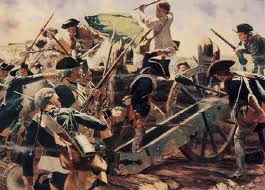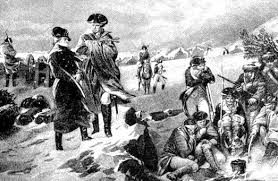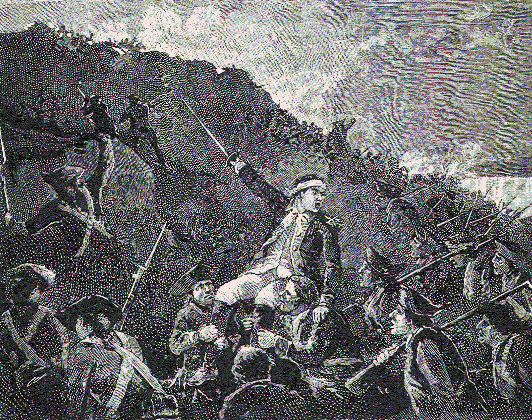|
For as long as young James Wagg could remember he had traveled with his parents each summer to Cape Elizabeth to visit Grandfather and Grandmother Crockett. Seeing the grandparents was alright but what he really liked was playing with the neighbor boy, Christopher Strout Jr. Chris and James were the same age but led quite different lives.
Chris’s father died at sea when Chris was 4 years old. His mother and her brother James raised the six children. Chris’s uncle James was a fishing boat captain and Chris spent his time on the water of Casco Bay. James Wagg, living on a farm “up the river” as the coast people thought of Danville, knew the cycle of planting and harvest, daily chores and tending the livestock. It was agreed by the adults that in the summer of 1764 Chris was to stay at the farm with the Waggs for the month of July and James would spend the month of August with Chris and his family.
The boys were delighted. James was an only child and Chris lived with his two younger sisters. Both boys, like most young mammals, craved the company of others of their kind. During the stay with the Strouts James learned that Chris’s mother was very proud to be one of the Smalls of Cape Cod. He paid no attention to the girls except at Dorcas’s 8th birthday party on August 16 he did give her a whistle he had made from an alder branch. Most of his time was spent with Chris and his uncle on their fishing boat.
This annual exchange of visits went on for 10 years. At about year three Dorcas announced that she would marry James. The boys had a good laugh but Dorcas just smiled to herself. In 1774 Chris married Mary Small, a distant cousin of his mother’s. In that same year James joined the Sons of Liberty.
James had never forgotten Dorcas’s declaration of intentions and as the years went by it seemed to James a better and better idea. At Chris’s wedding celebration James spoke to Dorcas about it.
“Is there to be a war against the Crown?” Dorcas asked.
“Yes” James answered.
“And will you fight?”
“I must.”
“Then I will not wed only to become a widow. I will wait until you return safely.”
So an engagement of indefinite length was made, and as James predicted the war came.
The following is the record of James Wagg’s enlistment:
Wagg, James Jr. Falmouth, Casco Bay. Private, Capt. Sewall's co.. Col. Ebenezer
Sprout's regt. ; Continental Army pay accounts for service from Jan. 1, 1777,
to Dec. 31, 1779 ; residence, Falmouth, Casco Bay ; also, Capt. Josiah Jenkins's
CO., Col. Samuel Brewer's regt. ; subsistence allowed from date of enlistment,
Jan. 1, 1777 ; credited with 77 rations ; subsistence also allowed for 14 days
travel on march to Bennington ; also, same co. and regt. ; return dated Camp
near Valley Forge, Jan. 23, 1778; residence, Falmouth; enlisted for town of
Falmouth ; mustered by Maj . Insley ; enlistment, 3 years.
James and Chris Strout joined together at Danville, which at that time was a district in the town of Falmouth. Major Insley was traveling around the southwest part of the district of Maine recruiting troops for Colonel Sprout’s regiment which was engaged at the battle of Princeton. They marched and drilled and practiced maneuvers.
The first action they saw was near Bennington in August where by luck they had been stationed since joining up. The British general Burgoyne sent a detachment of 700 mixed troops composed of dismounted Brunswick dragoons, Canadians, Loyalists, and natives to Bennington to steal horses, draft animals and supplies. Burgoyne was unaware that General Stark had about 1500 militiamen there reinforced by Colonel Seth Warner’s regiment and the Green Mountain Boys, together another 500 troops. Scouts had detected the approach of Burgoyne’s men and the rebels met them at Woomsac, New York about 16 miles east of Bennington.
Burgoyne’s men had just run into the rebels when the visibility dropped to about zero in what some of the men called the heaviest rain since the time of Noah. There was no way to fight or even to move much in the deluge. The order was, “Hunker down boys and for God’s sake keep your powder dry.”
As soon as movement was possible the rebels enveloped the British position and inflicted heavy casualties killing the leader of the British troops, Lieutenant Colonel Friedrich Baum. There was an attempt to reinforce the British by some reserve troops but they were driven off by the rebels. Burgoyne had lost about a thousand of his troops including reserve losses and the natives abandoned their support for the British cause.

Battle of Bennington
The boys were marched from Bennington under General Lincoln, up the Hudson to attack Fort Ticonderoga, held by the British. After some days of bombarding the fort without much effect, Lincoln marched his 2000 troops back down the river to join the rebel forces at Bemis Heights on September 29, 1777.
On October 7, 1777 General Burgoyne decided to attack the rebel army. He had somewhere around 6000 men able to fight. The rebels with the addition of Lincolns troops had 12,000 men and newly replenished supplies and ammunition. The result was the surrender of Burgoyne’s entire army. James and Chris came through the fight exhausted but unhurt. They had distinguished themselves with their marksmanship and an extraordinary ability to be at the right place at the right time.
After Saratoga, James and Chris were transferred to the regiment now under Colonel Samuel Brewer and were sent to join General Washington’s force in December of 1777. The wintering over in valley forge was worse than the battles the boys had experienced. Food and clothing was scarce. The cold was not as bad as the normal Maine winter but the chill and wet were unrelenting. After February 1778 conditions began to improve.

Valley Forge
During the rest of 1778 and first half of 1779 James and Chris participated in Washington’s action including the battle of Monmouth. In June of 1779 General Washington discreetly asked his commanders for a few of the best fighters from each of their regiments, to be placed under the command of General Wayne for a particular mission. James and Chris were both selected. That is why the boys found themselves at the battle of Stony Point about 35 miles up the Hudson River from New York City on July 15, 1779.
It was a night attack up steep hills that depended on stealth. The soldiers were armed with unloaded muskets with bayonets attached to prevent any accidental discharge from alerting the defenders.

Battle of Stony Point
About 1300 American soldiers fought at Stony Point. The losses were minimal, only 83 wounded and 13 killed. James was stabbed in the back by a bayonet but survived. Chris was shot through the throat and died almost instantly. The grief among the Strouts and Waggs was deep but Mary, Chris’s wife said, “Thank God we were married. I lived a thousand days of great happiness”.
James stayed on the farm at Danville for his convalescence and Dorcas lived there as well. Dorcas, taking a lesson from her sister-in-law Mary, determined to marry James as soon as practical. They were married in February of 1780 shortly before the death of James Sr. So James settled down on the farm in Danville where he and Dorcas raised their family and provided for his mother until her death in 1791.
The children were:
Elizabeth 1780 (died young)
Mary 1782
Samuel 1783
Dorcas 1787
Elizabeth 1789
Sally 1790
James 1790
James inherited a good bit of land in various parcels south and west of the Androscoggin River. In his own right he accumulated a lot more through careful trading. All the children were well provided for when they came of age. Dorcas died of an illness in 1825 and James lived on until 1847 when at the age of 93 he was painting the barn and fell from the ladder. At the time he was living with his grandson Joshua Miller in Durham. He was buried in the Old Wagg cemetery in Auburn.
|




